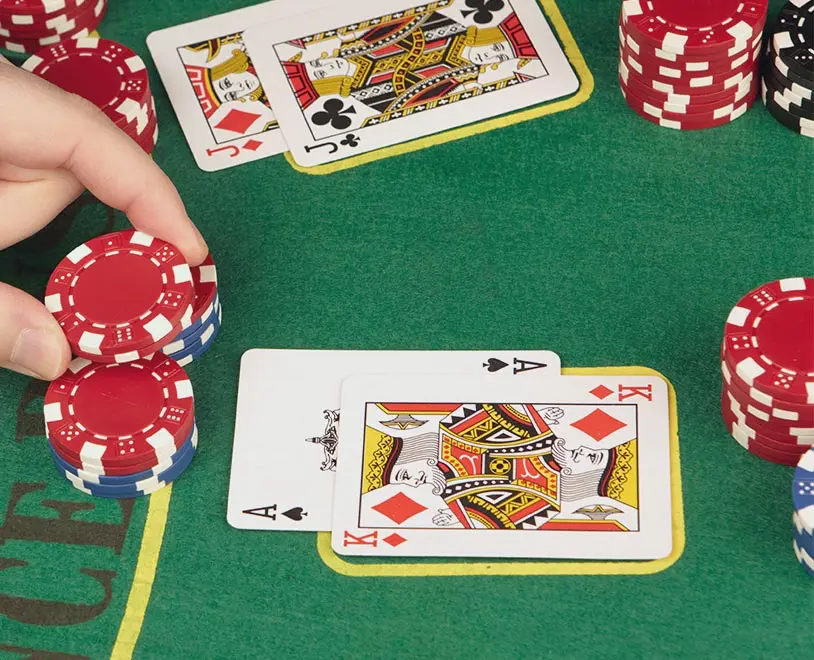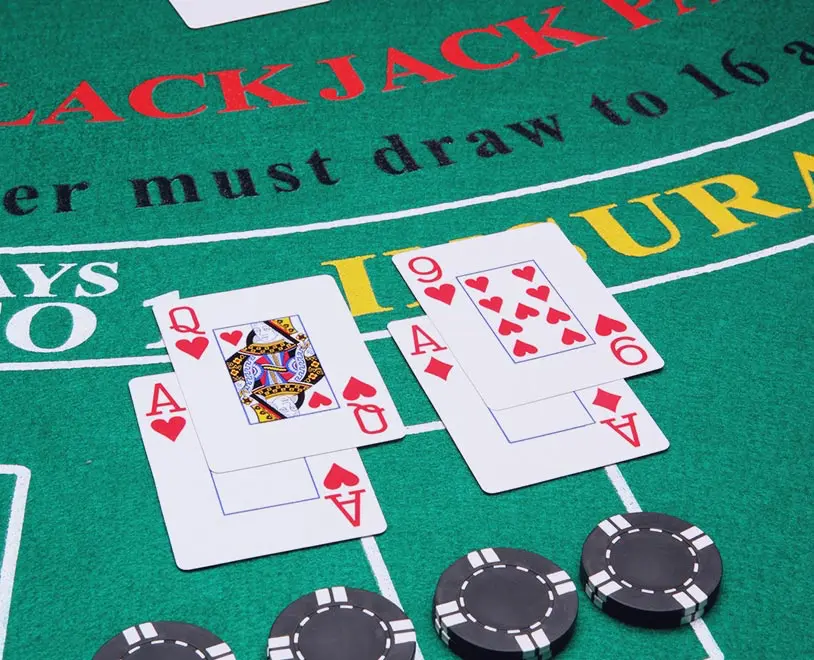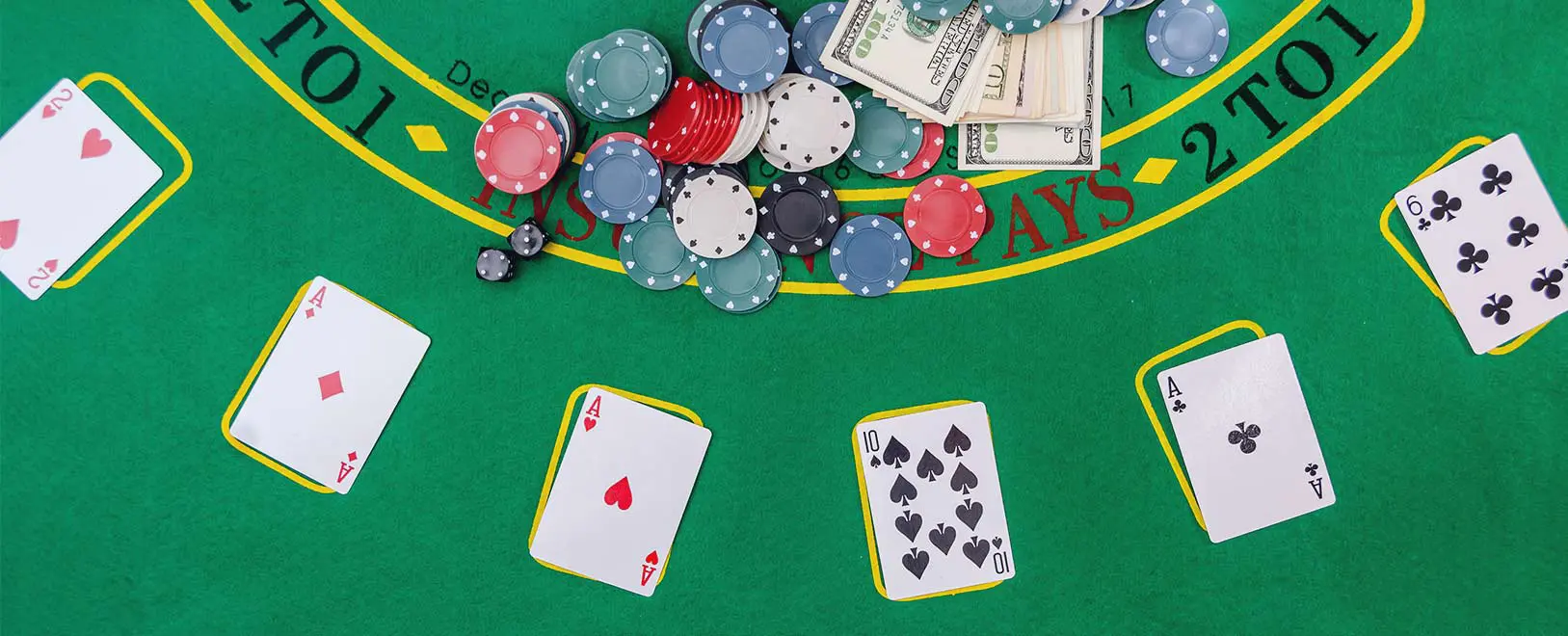Online Blackjack Guide
There’s a reason why so many casino players gravitate to Blackjack. This game has many layers of strategy, making it easy for casual players to jump in, while also providing enough depth to satisfy the sharpest casino minds. In this casino table games guide, we cover everything you need to know to get started in Blackjack, including some basic strategy.

Blackjack Overview, Rules and Odds
Blackjack is a card game played against the Dealer. The goal is to build a hand with a score that’s higher than the Dealer’s without going over 21 points. If either of you do exceed 21 points, it’s an automatic loss, which is known as a bust. On the off chance that you get the exact same score, the round is a push, and your bet is returned. On the lucky occasion where you get exactly 21 points on your initial hand, you have “Blackjack” and win automatically. The same goes for the Dealer.
The number of decks included depends on the version you’re playing; some versions use one deck, two decks, six decks and eight decks. The versions available in our casino use one, two and six decks. When all else is equal, using fewer decks results in a lower house edge.
Before getting started with the game, you need to memorize the card values. When playing Blackjack online, the score of your hand will always be calculated automatically, but it’s still a good idea to learn how to keep score. No matter which version you’re playing, Aces are worth 1 and 11 points interchangeably. They’ll always convert to 1-point if the 11 points results in a bust. Tens, Jacks, Queens and Kings are all worth 10 points, and everything else has face value.
Every round of blackjack begins with a bet. You can bet as little as $1 per round at Bovada Casino, and the maximum depends on the versions you’re playing. Standard six-deck Blackjack has a $500 max bet, while double-deck has a $250 max, and single-deck has a $300 max.
After placing your bet, you and the Dealer are dealt two cards each; your cards are placed face up in front of you, while the Dealer’s are arranged with one card face up and one face down; the face down one is referred to as the hole card. At this point, you must choose one of the following four actions:
Hit: Beef up your hand (and score) by tapping “Hit.” One card will be added to your hand. You may hit as many times as you’d like as long as your score is under 21 points.
Stand: If you like the score in front of you, keep it as is. Your score will be compared with the Dealer’s to determine the winner.
Double: Increase the stakes by doubling your bet. You’ll get one card added to your hand and then your turn ends.
Surrender: Some versions of Blackjack come with a “Surrender” option where you can forfeit your hand and retrieve half your bet.
Under certain circumstances, two additional actions will be available to you:
Split: When you receive two cards of equal rank upon first deal, splitting is an option. You can divide the pair into two individual hands; each newly split hand will receive a second card, at which point, you decide to hit, stand, double, or surrender.
Insurance: When the Dealer’s upcard is an Ace, you can protect yourself from Dealer Blackjack by making an Insurance side bet that’s half the amount of your wager. In the case where the Dealer’s hole card is 10-value (Dealer Blackjack), your Insurance side bet will make sure you don’t lose any money; it pays 2:1.
Although the rules of Blackjack vary game to game, there are some that apply to all. Familiarize yourself with them and you’ll be well on your way to becoming a pro.
- Blackjack pays 3:2.
- Insurance pays 2:1.
- All other hands pay 1:1.
- Split Aces receive one more card only.
- Getting an Ace and 10-value card after splitting isn’t considered Blackjack. It pays 1:1.
- Double any two cards.
- Decks are shuffled after each round.
One rule not included above is the “Soft 17” rule. In Blackjack, a soft 17 is a 17-point hand that includes an 11-point Ace. It’s soft because the Ace can still be converted to a 1-point Ace if you want to hit. When a hand is “hard,” the score can’t be converted. The Dealer must always play to a minimum score of 17, whether that score of 17 includes soft 17s depends on the version you’re playing. When all things are equal, Dealers hitting on soft 17 will add 0.22% to the house edge. In our casino, all versions of Blackjack except for Double Deck Blackjack and European Blackjack require the Dealer to hit on soft 17.
Top Blackjack Games to Play
Now that you know the rules of the game, you’re going to want to know what the best online Blackjack games are. Each version comes with a unique set of rules that affect everything from strategy to house edge. Here are our top Blackjack games according to the pros:
- Double Deck Blackjack
Enjoy the added edge that comes from the Dealer standing on soft 17 hands. This version uses two decks and lets you split up to two hands per round. The only downside is the lower betting maximum ($250), but if you plan on betting under $250 anyway, this version can’t be beat.
- The New Blackjack
Players went nuts over the first Blackjack launched in the suite of “New Blackjacks.” The interface is far more mobile-friendly than the Classic suite and offers a streamlined look that keeps you focused on the game—not extraneous buttons and details. This version includes the Surrender option.
- Single Deck Blackjack
It’s getting harder and harder to find Single Deck Blackjack in brick-and-mortar casinos. Luckily, you can play Blackjack online in our casino using just one deck. In this version, the Dealer hits on soft 17 and you can split up to two hands per round.
- European Blackjack
Across the pond, cards are dealt differently than here. At the start of every round, you receive your standard two-card hand as usual, but the Dealer receives just one card at first. Once your turn is complete, the Dealer gets his second card. The only time this change is apparent is when the Dealer gets an Ace in the initial deal. You’ll have to choose your actions before the Dealer gets a second card—which could potentially be a Blackjack.
- Perfect Pairs
This game offers extra betting opportunities with the Pairs side bet. If your initial two-card hand happens to be a true pair (King and Jack, for example, wouldn’t count even though they’re both 10-value cards in Blackjack), you win. There are unique payouts for a perfect pair (ex. two Jack of hearts), a colored pair (ex. Jack of spades, Jack of clubs), and a standard pair (ex. Two of hearts, Two of spades).

Advanced Blackjack Strategy
Betting systems have long been used in a variety of table games—blackjack included. One of the best-known, the Martingale, dates back to the 18th century when it was popular in France. Based on the idea that losing streaks cannot continue forever, the Martingale system proposes doubling one’s bet after each loss, so that when you eventually hit a win, you’ll win back everything lost and be up one bet. The only issue with the Martingale is that it can only work if the casino player has infinite wealth; when making progressively bigger bets, extended losing streaks can wipe out a modest bankroll.
Making an Insurance side bet often sounds like a good deal to beginner Blackjack players. For a small price, you can make sure you break even in the event of a Dealer having a natural. But in reality the 2:1 payout ratio doesn’t match the odds of a Dealer Blackjack, which occurs roughly one third of the time. The only time the Insurance bet makes sense is when counting cards leads you to believe the shoe is rich in 10-value cards.
When people think of advantage play with Blackjack, they think of card counting. This is the final step in developing a sound Blackjack strategy, but should be done only after mastering basic strategy. Online, you’ll find strategy charts for every type of Blackjack; these charts list the optimal move for every combination of Dealer upcard and Player score. Print it out and use it while practicing. Once it’s memorized, it’s time to up the ante.
Counting cards, which can be done only at a location-based casino, involves learning a point system for several groups of cards and then adding and subtracting a running count as you watch the cards pass through the table. A common system (Hi-Lo) has low cards (Two to Six) worth +1, Seven to Nine worth 0, and the rest worth —1. A high running count means the shoe is rich in 10-value cards; the advantage play comes from increasing bet sizes when the count is high. While counting cards certainly flips the edge and benefits casino players, it should be done with caution. Casinos reserve the right to refuse service to patrons they suspect are using advantage play, and card counting is often categorized as that. Use these techniques at your discretion and enjoy the journey to mastering Blackjack.
